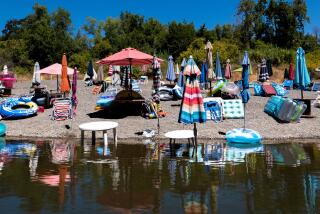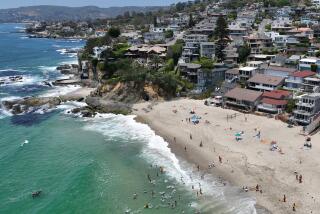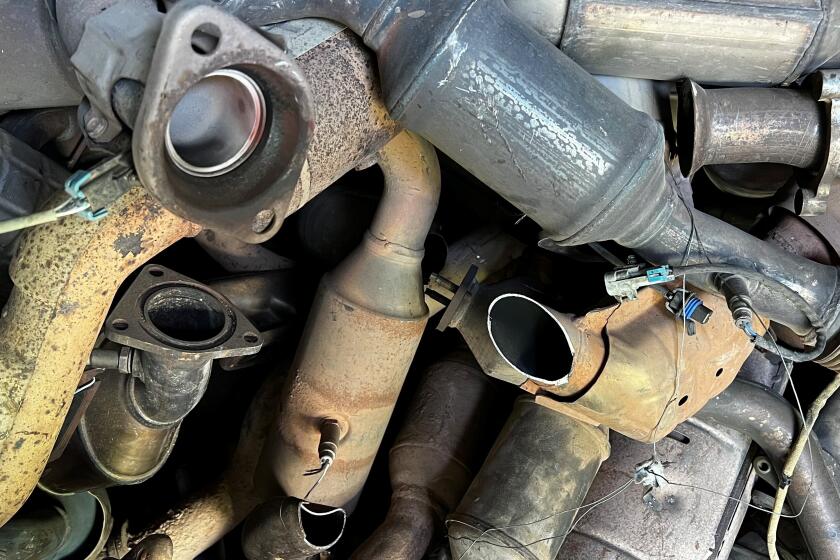A CITY IN CRISIS : No Day at the Beach : Closures: Seeking refuge from the turmoil, many beach-goers are turned away from county oceanfronts by National Guardsmen.
- Share via
It was not long after 6 a.m. and Venice Beach local Chris Wieczorek was just settling onto his board for a morning of surfing. But a squad of green-uniformed National Guardsmen had different ideas, striding onto the sand and ordering the beefy blond man out of the water before he could shred a single wave.
“I’ve lost my freedom because some hoodlums are causing trouble,” a glum Wieczorek said later. “Surfing is my freedom. (But) they have M-16 (rifles) and all I have is a surfboard. So what am I going to say?”
Wieczorek was just one of thousands of frazzled Angelenos thwarted Saturday when they sought the peace and solace of the beach. The county had closed beaches in Venice and Playa del Rey at the request of the Los Angeles City Council, in a move the politicians hoped would prevent a spread of the civil unrest that had torn across the city for more than three days.
Those beaches were totally and strangely vacant on a warm, breezy Saturday that normally would have attracted more than 100,000 people, lifeguards said.
Just to the north, in Santa Monica, city officials left the beaches open but closed all coastal parking lots. Beach attendance was only about a quarter of its normal 110,000, said Lorry Haddock, a senior lifeguard.
The closures were scheduled to continue today, with beaches likely to reopen Monday, said Los Angeles City Councilwoman Ruth Galanter, who recommended the action after dozens of calls from constituents.
But many of those turned away complained bitterly that they had been denied a chance of relief from the oppressive smoke and sirens of the riot zones in the inner city.
Hundreds of cars poured to the western terminus of the Santa Monica Freeway throughout the day, only to find they couldn’t park at lots in Santa Monica. Cars, many loaded with Latino families, made quick U-turns and apparently headed for home.
Leonar Casillas, 19, and several friends had packed into cars to escape their Koreatown neighborhood, which had been ravaged by arson and looting.
“We came here to have a good time,” said a disheartened Casillas. “All week we have been in the house, and we just wanted to have some fun. I think they should leave it open, because it’s calm right now.”
Said Luis Garcia, 20, who could not decide what to do after finding the parking lots closed: “The people want to come here because it is no good, the air, where we live. Here it is clean.”
In eclectic, opinion-on-every-corner Venice, the regulars were having a particularly hard time dealing with the loss of access to the cooling water and their beloved Ocean Front Walk.
A bearded man in a tie-dyed shirt told friends at a corner cafe that they should thrust flowers into the rifle barrels of the guards. A gray-haired man, describing himself as an “ordained peace-maker,” played a tape of the Rev. Martin Luther King Jr. from his second-floor apartment over Ocean Front Walk. And a 39-year-old sand sculptor in beaded denim suggested that the beach closure and arrival of the Guard were all part of a government plot “to tighten totalitarian control.”
A few blocks down the strand, at the Carousel fast-food restaurant, owner Mansour Alai said he thought the beleaguered city should have been allowed a day at the beach--a sort of collective cool dip after the fear and anxiety of the days of rioting.
“If they close the beach, people stay home and get too much pressure and more worry,” Alai said. “If they could come to the beach, the people could relax and solve the problem.”
Alai also conceded he needed the business. His beachfront establishment had already suffered through an unusually cool summer and an unusually wet winter.
Others, however, said the closures were the only way to keep the peace.
“I think it’s a real good idea to close it down,” said Tony Panzica, 26, of Culver City, after two National Guardsmen stopped him from walking to the Venice Pavilion. “I see gangs down here all the time with guns anyway. They wouldn’t be able to control the crowd.”
A cafe manager, who asked to remain anonymous, said the closure was “the right decision” because of the sometimes explosive mix of rival groups who sprinkle the carnival-like scene along Ocean Front Walk.
On both sides of the beach-closure debate, one thing was agreed: The sight of uniformed guards on the beach would never be forgotten.
Dozens of passersby stopped to give the guards thumbs-up signs or to pose with them for pictures--including three bikini-clad women who cozied up to a pair of men in full battle gear.
Donald Lank of Playa del Rey watched and took pictures as 150 guardsmen prepared to depart after patrolling Dockweiler State Beach through the night. “It looks like the invasion of Normandy or something,” Lank said.
Back at Venice Beach, a sunburned, bare-chested man watched as the Guard moved into position along Ocean Front Walk.
“It’s surrealistic,” he said, shaking his head. “Totally surrealistic.”
Time staff writer Petula Dvorak contributed to this story.
More to Read
Sign up for Essential California
The most important California stories and recommendations in your inbox every morning.
You may occasionally receive promotional content from the Los Angeles Times.











